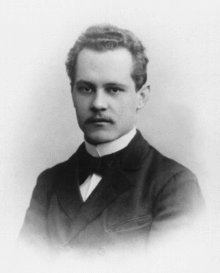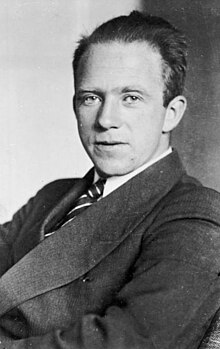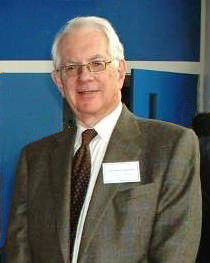For some mysterious reason, maybe because I am too shy (and I will remain shy, as you will see below) ;-), I have never written about physicists' anniversaries celebrated on December 5th. While Czech children are served a trio of an angel, St Nicholas, and a devil tonight (only 20% of the Czech households ordered one this year, however),

people are being born and they're dying, too. Believe me, I know something about it – thankfully about the former only so far. The physicists born on December 5th could have felt discriminated against. Let's try to correct this injustice.
December 5th is a pretty black day for music: in 1791, Wolfgang Amadeus Mozart died. In fact, many other composers made the same serious mistake – I would even call it a fatal mistake – on the same date. The day was dark for literature and painting as well: Alexander Dumas and Claude Monet died on December 5th. However, the day isn't so bad for physics.
 Arnold Sommerfeld was born on December 5th, 1868, in Königsberg, East Prussia – now Kaliningrad in the tiny island of Russia between Poland and the Baltic states. He worked on maths for quite some time: David Hilbert, Göttingen (the global capital of maths at that time)...
Arnold Sommerfeld was born on December 5th, 1868, in Königsberg, East Prussia – now Kaliningrad in the tiny island of Russia between Poland and the Baltic states. He worked on maths for quite some time: David Hilbert, Göttingen (the global capital of maths at that time)...Among the physicists, he was nominated for the Nobel prize record 81 times (a certain social connectedness explained below is the likely reason) but he has never gotten it. Sommerfeld could boast a scar from fencing, too.
He introduced the concept and calculated the value of the fine-structure constant in 1916. It's \(\alpha=1/137.036\) or so according to modern accurate measurements although it was believed to be around \(1/136\) many decades ago. Sommerfeld realized that this combination is needed to get a characteristic value of the strength of the electromagnetic interactions that is dimensionless i.e. independent of the units. We would agree with extraterrestrial aliens about the value as long as these aliens would be fair and balanced.
More nontrivially, he figured out the Sommerfeld identity relating two forms of Bessel functions. The 1919 Sommerfeld-Kossel displacement law related the ionization spectra of adjacent elements in the periodic table. He proposed an elliptic refinement of the old Bohr model of the atom, the Bohr-Sommerfeld model. The elliptic trajectories allowed him to interpret some new quantum numbers and he wrote the quantization conditions in a way that was closer to the not-yet-born modern quantum mechanics. He co-authored the Drude-Sommerfeld model, the free electron model for valence electrons in crystals and metals.
One could spend a lot of time by explanations of these advances that were very important. Instead, let me mention that Sommerfeld was a key physics educator. Wikipedia lists 26 of his students, 22 of which were grad students, including Wolfgang Pauli, Peter Debye, Hans Bethe, Rudolf Peierls, Linus Pauling, and many slightly less famous ones. The total body of work that has been done by his students is stunning.
And I haven't even mentioned another earthshaking student of Sommerfeld. His name was Werner Heisenberg.
Werner Heisenberg
 Werner Heisenberg was also born on December 5th, like his adviser (birthday is the first thing that a good grad student should learn from his adviser), but in 1901. He was born in Würzburg, exactly in between the Easternmost corner of France and the Westernmost corner of Czechia on the map of Germany.
Werner Heisenberg was also born on December 5th, like his adviser (birthday is the first thing that a good grad student should learn from his adviser), but in 1901. He was born in Würzburg, exactly in between the Easternmost corner of France and the Westernmost corner of Czechia on the map of Germany.His father was an immensely achieved professor of classical languages, especially Greek. Werner studied in Munich under Sommerfeld as well as Wilhelm Wien. It was in the early 1920 and Heisenberg was already getting ready to revolutionize the world of physics. His adviser Sommerfeld did the best things he could for his students. He noticed that Werner was intrigued by the (old) quantum stuff so he managed to get a spot for Werner at a Bohr festival in June 1922 (Göttingen). Heisenberg and Bohr met for the first time over there. The friendship was destined to last.
Heisenberg is such a great figure in physics that I won't attempt to describe everything he did here. Some of it is covered in 105 other articles on this blog. Aside from the uncertainty principle and much of matrix mechanics (the original, Heisenberg picture of quantum mechanics), he discovered or constructed Heisenberg's microscope (a wrong thought experiment about the resolution of microscopes), isospin (a quantum number mathematically analogous to the spatial spin, making the doublet out of the proton and the neutron), the Euler-Heisenberg Lagrangian (a non-linear modification of QED proposed to regulate the UV divergences in electron's mass – an approach made obsolete by renormalization), the Kramers-Heisenberg dispersion formula (for cross section of scattering of photons against atomic electrons), and the Heisenberg group (of some upper triangular matrices).
But less typically, Heisenberg has also done work on turbulent flows, the atomic nucleus, ferromagnetism, and cosmic rays. His failed leadership in the development of the German nuclear bomb shows that a great physicist's failure may sometimes be a good thing. During the war, he was just incapable of making the estimate of the critical mass of uranium right. I think that he wanted to do the job carefully but he didn't.
Eine kleine Nachtmusik. Mozart died on December 5th, 1791. Mozart had never forgotten that Prague appreciated his work even when Vienna scorned him. "My Praguers understand me," he famously said.
As a kid, he was a German Scout, got into the German Youth movement, too. You shouldn't imagine that all of it was about politics: it was mostly apolitical. At any rate, he has always been a conservative and a German patriot to the extent that he vaguely endorsed the Nazi establishment and did some work for it, too.
In 1942, he published a paper on the S-matrix. After the war, he became a proponent of the S-matrix program that gradually evolved into the bootstrap paradigm. The idea is based on a wishful thinking (closely related to the partly obsolete dreams about the uniqueness of the stringy vacua etc.) that the general consistency criteria in a QFT-like theory dictate all the spectrum and interactions. He believed that we shouldn't prescribe the elementary fields and we shouldn't qualitatively distinguish elementary and composite particles. The theories should imply all the particles, remain silent about each particle's compositeness (each of them is partly elementary, partly composite – a comment that pretty much applies to strong coupling, if I use some modern jargon), and determine the interactions, too. It should be maximally non-constructive, so to say.
This philosophy got more or less defeated because the successful theories (later parts of the Standard Model) were very constructive, starting from well-defined fields. But the Heisenberg-inspired bootstrap paradigm was the soil in which string theory was born. However, even string theory got "very constructive" rather soon, so the bootstrap vision hasn't been realized by real-world string theory, either.
Heisenberg's life and work is just too much for a single blog entry. Because of Heisenberg's proximity to the official German institutions of the 1930s and 1940s, you could feel some kind of a bad flavor, perhaps even an anti-Jewish flavor. In that case, I have a great fix.
Sheldon Glashow
 Sheldon Lee Glashow was born in New York City to a Jewish family (originally from Russia) on December 5th, 1932, so he celebrates his 80th birthday today. Wonderful! I sent him this advent calendar (hover your mouse about each of the 100 persons and non-persons) and he replied it was "great". ;-)
Sheldon Lee Glashow was born in New York City to a Jewish family (originally from Russia) on December 5th, 1932, so he celebrates his 80th birthday today. Wonderful! I sent him this advent calendar (hover your mouse about each of the 100 persons and non-persons) and he replied it was "great". ;-)A recent Gallup poll found out that 60% of the visitors of Wikipedia notice that Glashow's photograph above has some fingers on his right shoulder while 0% of the visitors know whose fingers they are. Well, I can tell you because I took this picture – in the Harvard's Science Center during the 2005 Sidneyfest. It's the fingers of Kenneth Lane of BU, a technicolor guy who was trying to provoke Harvard string theorists at the same time, in a friendly way, of course.
Glashow attended the Bronx High School of Science and one of his classmates was named Steven Weinberg. He got his BA at Cornell and PhD at Harvard. Julian Schwinger, Glashow's adviser, chose a rather lucky problem for Glashow: improve the lame attempts by Schwinger and construct some kind of a unified electroweak theory, with a gauge group like \(SU(2)\times U(1)\), and bring order to these two-out-of-four fundamental physical interactions. How did Glashow react? He took the lame attempts, discarded most of their details, and constructed some kind of a unified electroweak theory, with the gauge group \(SU(2)_W\times U(1)_Y\), and brought order to the two-out-of-four fundamental interactions in Nature. It sounds easy but it wasn't that easy.
Glashow shared the well-deserved 1979 Nobel prize in physics with Weinberg and Abdus Salam. The latter two mostly added the Higgs field in the late 1960s. I won't try to describe all the history correctly because it could have many bugs.
Glashow predicted the charm-quark together with James Bjorken in 1964, just by some (ultimately correct) "sentiments". He made the evidence for the existence of the fourth quark much more convincing in his 1970 paper "Weak Interactions with Lepton–Hadron Symmetry" with Luciano Maiani and John Iliopoulos; their construction is known as the GIM mechanism. The paper showed that the fourth quark is the most natural player that achieves the suppression of \(\Delta S =\pm 2\) flavor-changing processes while it allows those with \(\Delta S=\pm 1\), in agreement with observations. Note that \(S\) is the strangeness.
In 1973, Glashow with Howard Georgi at Harvard proposed the first minimal \(SU(5)\) grand unified theory. The theory predicts rather speedy proton decay which was soon ruled out. The authors lacked courage – of course, they describe it differently (it's science to abandon your baby instead of trying to nurture it and shape it, they think!) – and immediately abandoned the whole program. Of course, the grand unification approach to non-gravitational interactions is alive and well and it may be motivated in many ways. I think it's more likely than not that some sort of grand unification is a valid approximation at some high energy scale. String theory allows both grand unified vacua and those without grand unification, too, so even a belief in string theory isn't enough to settle the question whether grand unification exists in Nature. Both answers are possible.
In May 1986, right after the greatest salvos of the first superstring revolution, string theorist Paul Ginsparg – ready to invent the arXiv in a few years – and Sheldon Glashow wrote an early (and therefore relatively friendly) criticism of string theory called Desperately Seeking Superstrings for Physics Today. They didn't like that string theory's (or quantum gravity's) characteristic phenomena were inaccessible to doable experiments. That's nice but that doesn't mean that one can't study them.
All the later critics of string theory were just trying to repeat these 2.5 superficial pages of criticism thousands of times, much more idiotically and in a much more hostile way. They didn't add anything new at all, not even to the trash-talk; even the terms "String Wars" and the quote "Not Even Wrong" may be found in that two-page 1986 article.
In the mid 1990s when the second superstring revolution exploded and one could see that the amazing progress a decade earlier wasn't an isolated fluke, it became clear that every good physics department at every good university has to have a strong string theory group. Harvard had to create its own powerful string theory group, too. And it did. Sheldon Glashow didn't like it and emigrated to Boston University.
In some sense, string theorists also threw him out of their natural community as an artifact from the history textbooks of physics and I think it's wrong. People like Glashow obviously don't understand stringy seminars etc. and it wasn't just his fault; it's also their communication skills' fault. Teaching string theory – and the reasons behind its demonstrable inevitability – to Glashow was something I wanted to do at some point because I think that important and utterly sensible (and not yet senile) physicists such as Glashow simply shouldn't remain ignorant about the most important developments done by the "generation younger by one" just because of some bizarre stubbornness but it has never happened (so far).
The Boston University's physics group has done some fair, normal, somewhat interesting and occasionally exciting work in physics but I kind of believe that Sheldon Glashow realizes that what has been done in high-energy theoretical physics at the Harvard group between the mid 1990s and now is more important than what has been done at the BU. I am not saying that the results at BU weren't legitimate and impressive pieces of physics work. But there's the extra X-factor linked to true conceptual advances such as microscopic calculations of black hole entropy or the AdS/CFT correspondence in whose light the work at the BU may look mediocre.
Glashow is remaining immensely active, however. To mention the most cited papers since 1995, he co-authored a 1998 paper with Sidney Coleman in which they found all the 46 CPT-even perturbations of the Standard Model that break the Lorentz symmetry but preserve the consistency conditions. Note that he is affiliated with Harvard on that paper. In 1997, he wrote another paper with Coleman about cosmic ray and neutrino tests of special relativity.
In 2002, Glashow wrote a paper with Paul Denise Milani Frampton that just surpassed 250 citations now – about cosmological signatures of neutrino CP-violation. He actually wrote several more papers above 100 citations with Paul Frampton. Another typical co-author of well-known papers was Andrew Cohen (whom I wrote a paper with, too: so the author distance between me and Glashow is 2 steps). Most recently, in September 2011, Cohen and Glashow presented a simple yet very explicit argument why the neutrinos couldn't be superluminal because even if they were, assuming some Lorentz-breaking but still quantum field theory, they would quickly lose the energy by emitting electron-positron pairs (a sort of Bremsstrahlung).
I've met Glashow at various physicists' dinners, and so on, a fun guy. Glashow is mentioned in 79 TRF articles.
Sorry, I will skip Cecil Frank Powell (a Nobel prize winner) and the two Italian guys... Also, James Stirling who died on this day in 1770 will be ignored because at the end, I didn't use his approximation to win $300 in a recent challenge.
0 comments:
Post a Comment